Muslim Prayer: How to Perform Salah
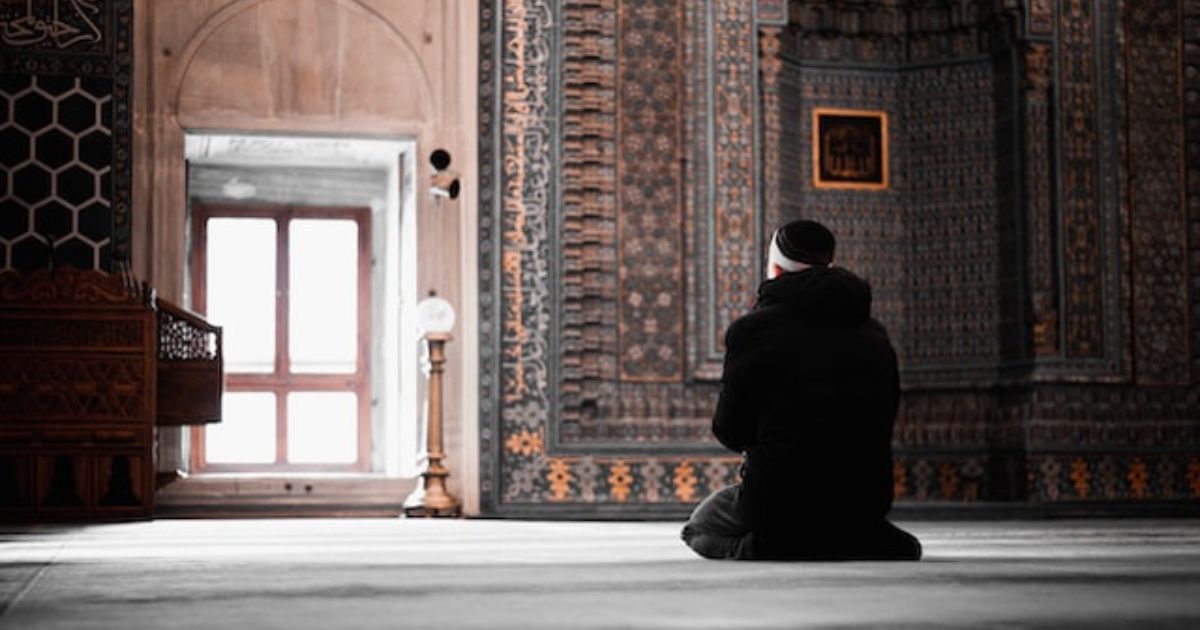
Muslim life should be based on the five primary pillars of faith. Each Muslim must fulfill and perform the five pillars of Islam in their lives, which are: faith or Shahada, Salah, Alms, Fasting, and pilgrimage. Salah, or the daily Muslim prayer, is not just intended to be a mandatory enactment.
Salah is also seen as a spiritual practice that can help with self-purification and also as a practice that can help to build a deeper connection between a believer and Allah SWT. While there are no acceptable excuses for Muslims to neglect Salah, there are several specific requirements for Muslims to complete before the compulsory daily prayers become mandatory.
When Muslim Prayer Becomes Mandatory
Salah becomes mandatory for a Muslim once a Muslim reaches the age of puberty. But, this obligation can come with an exception for those who may not be able to complete it due to physical or mental disabilities. Physical disabilities refer to women who are experiencing menstruation and postnatal bleeding (nifas).
Fatima bint Abi Hubaish asked Prophet Muhammad SAW, "O Allah's Apostle! I do not become clean (from bleeding). Shall I give up my prayers?" Prophet Muhammad replied, "No, because it is from a blood vessel and not the menses. So when the real menses begins, give up your prayers and when it (the period) has finished, wash the blood off your body (take a bath) and offer your prayers." (Sahih Bukhari 306).
Muslims who are sick or who can\'t perform salah physically in the traditional form are permitted to perform the prayers in any position that is comfortable for them, such as sitting or lying down.
Preparation for Muslim Prayer (Salah)
Before Muslims perform their prayers, one must be in a state of cleanliness. Wudu, or the Islamic ritual of self-purification and cleanliness, consists of washing the face, arms, and feet with water, each step having to be done in order. In other cases, where Muslims can't find the nearest water source around them, there is also another ritual of ablution, which is called Tayammum or Ghusl, using purified sand or stone.
Before performing the actual salah, a Muslim has to complete several requirements below:
- To be mature and sane, one must pray with the correct intention and know whether to perform fard, sunnah, or nafl prayer.
- To have completed wudu.
- Wear clean and proper clothing. The prayer shawl must extend from the navel to just below the knees on males. For females, clothing must cover the entire body with the exception of the hands and face.
- Praying in the direction of Mecca's sacred Kaaba.
- Praying at the times prescribed for salah.
How to do Muslim Prayer (Salah)
After a Muslim cleans his or herself with Wudu, and wears the proper cloth that is free from impurities and covered the aura now a Muslim can perform salah.
Step 1: Stand and Face The Qibla

Stand upright facing the direction of the Kaaba, or the holy mosque in Mecca. This step is called Qiyamah, and the direction is universally called Qiblah in the Muslim community. Aside from standing directed to the Kaaba, make sure the praying area is clean.
Step 2: Niyyah
Salah begins with the proper intention or niyyah, which can be done verbally or intentionally in your mind. The purpose of this step is to be aware of what kind of salah you are about to offer to Allah, so the prayer won't count as headless.
For example, to declare the niyyah, you can say, "I intend to offer the _ rakat of the _ prayer seeking nearness to Allah, in obedience to Him."
Step 3: Takbir
Direct the gaze toward the sajada or the prayer mat. With the palms open, raise your hand to your ears (for males) and raise your hands to your shoulders (for females) and say the Takbir "Allahu Akbar" which means Allah is the Greatest, and this movement called Takbiratul Ihram.
Step 4: Takbiratul-Ihram

After the Takbir, place your palms across each other at chest level and begin silently reciting Thana.
سُبْحانَكَ اللَّهُمَّ وَبِحَمْدِكَ، وَتَبارَكَ اسْمُكَ، وَتَعَالَى جَدُّكَ، وَلاَ إِلَهَ غَيْرُكَ
This means: "O Allah, how perfect you are, and praise be to you. Blessed is your name, and exalted is your majesty. There is no god but you."
Then recite silently Tauz or Taa'awwudh
اعوذ باللہ من الشیطان الرجیم
Meaning: I seek Allah's protection from Satan, the accursed
Tasmiyah came after that.
This means: in the name of Allah, the Most Gracious and the Most Merciful
Step 5: Recite Al-Fatihah
After completing the steps above, then recite Suratul Fatihah (the opening chapter) of the Noble Quran.
اَلْحَمْدُ لِلّٰهِ رَبِّ الْعٰلَمِیْنَۙ(۱) الرَّحْمٰنِ الرَّحِیْمِۙ(۲) مٰلِكِ یَوْمِ الدِّیْنِؕ(۳) اِیَّاكَ نَعْبُدُ وَ اِیَّاكَ نَسْتَعِیْنُؕ(۴) اِهْدِنَا الصِّرَاطَ الْمُسْتَقِیْمَۙ(۵) صِرَاطَ الَّذِیْنَ اَنْعَمْتَ عَلَیْهِمْ غَیْرِ الْمَغْضُوْبِ عَلَیْهِمْ وَ لَا الضَّآلِّیْنَ۠
This means All praise and thanks to Allah, the Lord of the Worlds, the Most Gracious, the Most Merciful, and the Master of the Day of Judgement. We worship you alone, and we seek assistance only from you. "Guide us along the straight path—the path of those whom you favored, not of those who earned your anger or went astray."
When you pray alone, Al Fatihah has to be recited in each unit of Rakah. But, when you pray in congregation or jummah, then it's not necessary for you to recite it.
Step 6: Recite Any Other Surah from Qur'an
Once you have recited Al Fatihah, now recite the other passage of your choice from the Quran. But before reciting the surah, it's important to start any surah with بسم الله الرحمن الرحيم and followed by another surah. Surah Ikhlas is commonly recited during salah because it is one of the shorter surahs in the Quran.
This additional surah after Al Fatihah is only mandatory for the first two rakat. For prayers that exceed two rakat, you only need to recite Surah Al Fatihah
Surah Ikhlas: بسم الله الرحمن الرحيم قل هوا لله أحد،الله الصمد، لم يلد و لم يولد، و لم يكن له كفوا أحد
This means: In the name of Allah, the most Gracious and the most Merciful. Say, He is Allah, the One. Allah is Eternal and Absolute. He begets not, nor was he begotten. And there is non-co-equal unto Him.
Step 7: Bow Down (Ruku')
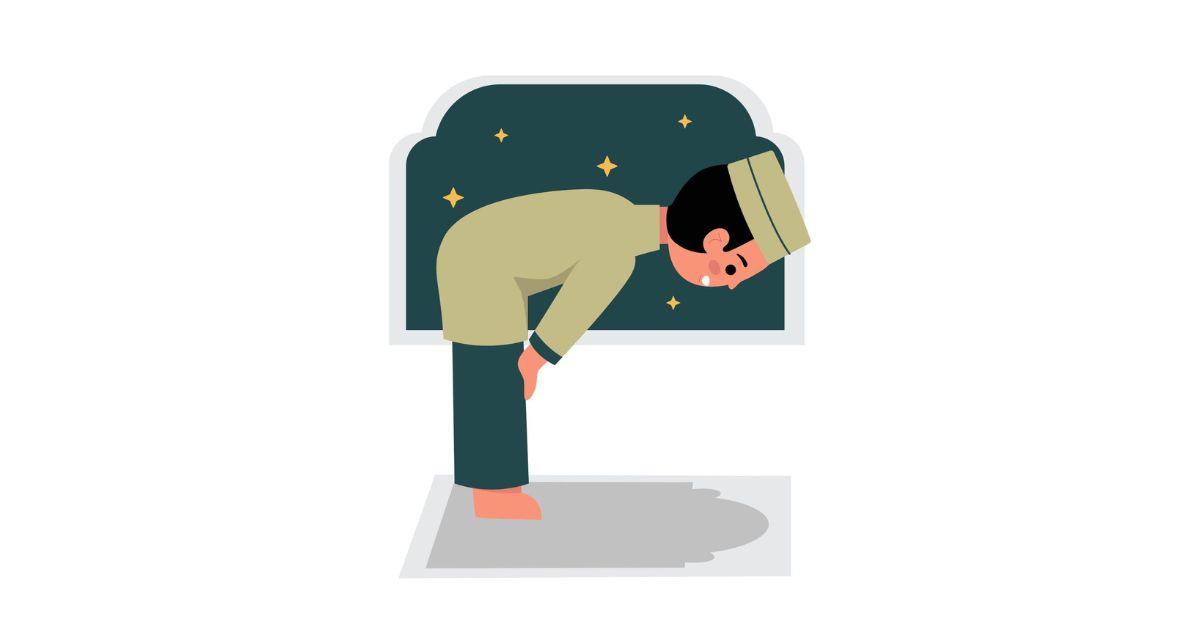
After finishing the additional surah, the worshipper says "Allahu Akbar" and bends for ruku'. Ruku is the position where the worshipper keeps the head and back aligned while the hands are on their knees. During the position, the worshipper recites Tasbeeh three times.
سُبْحَانَ رَبِّيَ الْعَظِيمِ
This means: Glory be to my Lord Almighty
During ruku', it's important for Muslims to keep their gaze downward to the place of Sujood.
Step 8: Raise from Ruku' (i'tidal)

Stand up from the bowing position while saying
سَمِعَ اللَّهُ لِمَنْ حَمِدَه
This means: Allah hears those who praise Him
Followed with,
رَبَّنَا وَلَكَ الْحَمْد
Meaning: Our lord, to You be the praise
According to the Hambali Fiqh, worshippers can raise both hands up to your earlobes before entering the ruku' position and after coming from ruku'. While coming up from ruku', the hands should be at your side and not crossed at the chest like the first standing position.
Step 9: Prostrate (Make Sujud)
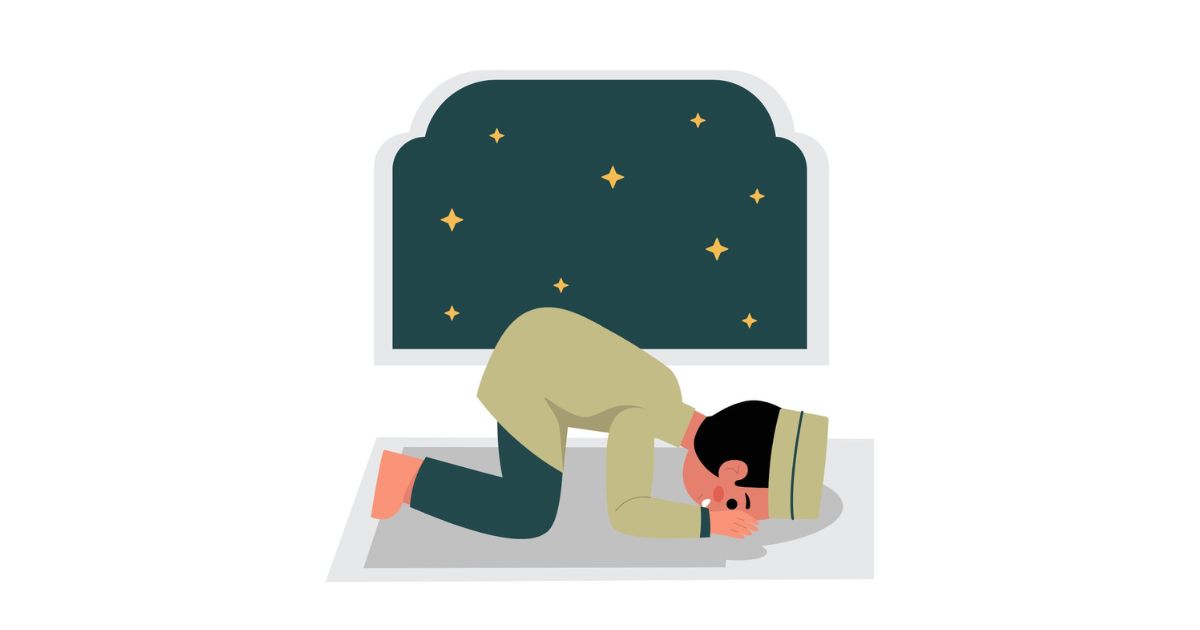
Say Allahu Akbar and proceed to prostrate on the floor with your forehead, nose, palms of both hands, and knees touching the floor. While prostrating or doing Sujood, make sure the elbows are raised away from the ground and during this position, recite Tasbeeh three times
سُبْحَانَ رَبِّيَ الأَعْلَى
Meaning: How perfect is my Lord, the Highest
Step 10: Sit on Your Knees (Iftirash)

Say "Allahu Akbar" and sit upright. Sit upright with your knees bent and palms placed on the thighs with the fingers on the knees. And recite the following words:
رب اغفر لي
Oh, my Lord, forgive me.
Say "Allahu Akbar" and prostrate for the second time while reciting the same recitation as the last Sujood three times.
Step 11: Stand Up and Complete Second Rakat
All of the moves we have mentioned above complete one unit of Rakat. Stand up and complete the second Rakat, except that you do not recite "Subhanakan" at the start of the standing position, and after the second Sujood, sit on your left leg while keeping your right foot upright, place your right hand on your right thigh and your left hand on your left thigh, and recite Tashahhud.
التَّحِيَّاتُ الْمُبَارَكَاتُ الصَّلَوَاتُ الطَّيِّبَاتُ لِلَّهِ السَّلاَمُ عَلَيْكَ أَيُّهَا النَّبِىُّ وَرَحْمَةُ اللَّهِ وَبَرَكَاتُهُ السَّلاَمُ عَلَيْنَا وَعَلَى عِبَادِ اللَّهِ الصَّالِحِينَ أَشْهَدُ أَنْ لاَ إِلَهَ إِلاَّ اللَّهُ وَأَشْهَدُ أَنَّ مُحَمَّدًا رَسُولُ اللَّهِ
Meaning: All the best compliments and prayers and good things are for Allah. Be at peace and may Allah's mercy and blessings be on you. Oh, Prophet! Peace be on us and on the pious slaves of Allah. I testify that none has the right to be worshipped but Allah, and I also testify that Muhammad is Allah's slave and His Apostle.
While reading the shahada part, make sure to ball up your right hand into a fist and raise your index finger. This movement symbolizes Tawhid, or the oneness of Allah.
At this point, if the salah consists of more than two rakat, then proceed to stand up and complete another rakat. But, if the salah consists of two rakat, then continue with this following supplication, known as Salawat with Tawarruk position.
اللَّهُمَّ صَلِّ عَلَى مُحَمَّدٍ ، وَعَلَى آلِ مُحَمَّدٍ ، كَمَا صَلَّيْتَ عَلَى إِبْرَاهِيمَ وَعَلَى آلِ إِبْرَاهِيمَ ، إِنَّكَ حَمِيدٌ مَجِيدٌ ، اللَّهُمَّ بَارِكْ عَلَى مُحَمَّدٍ ، وَعَلَى آلِ مُحَمَّدٍ ، كَمَا بَارَكْتَ عَلَى إِبْرَاهِيمَ ، وَعَلَى آلِ إِبْرَاهِيمَ ، إِنَّكَ حَمِيدٌ مَجِيدٌ
O Allah, let your mercy come upon Muhammad as you let it come upon Ibrahim and the family of Ibrahim O Allah, bless Muhammad and the family of Muhammad as you blessed Ibrahim and the family of Ibrahim. Truly, you are praiseworthy and glorious.
Step 12: Finish The Prayer with Tasleem
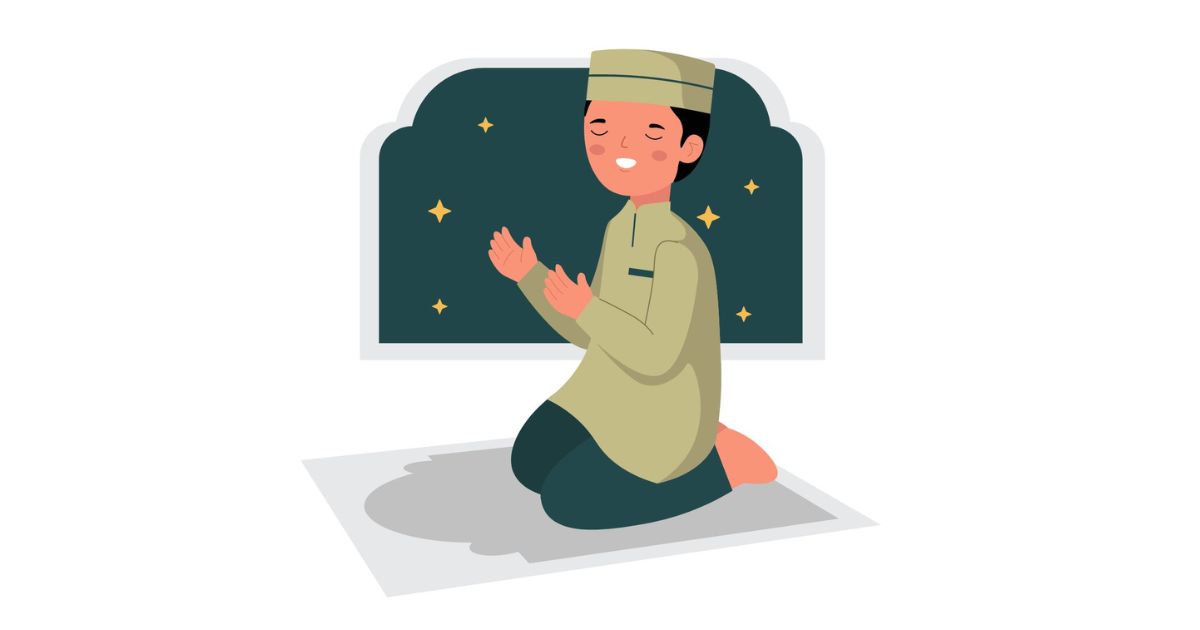
After you finish the Shalawat turn your face towards looking over your right shoulder and then turn left while reciting
السَّلاَمُ عَلَيْكُمْ وَرَحْمَةُ اللهِ
Meaning: Peace and the mercy of Allah be on you.
Step 13: Dua and Dzikir
After finishing your salah, it is recommended to offer dua and dzikir, especially after Fardh salah.
The Importance of Daily Muslim Prayer in Islam
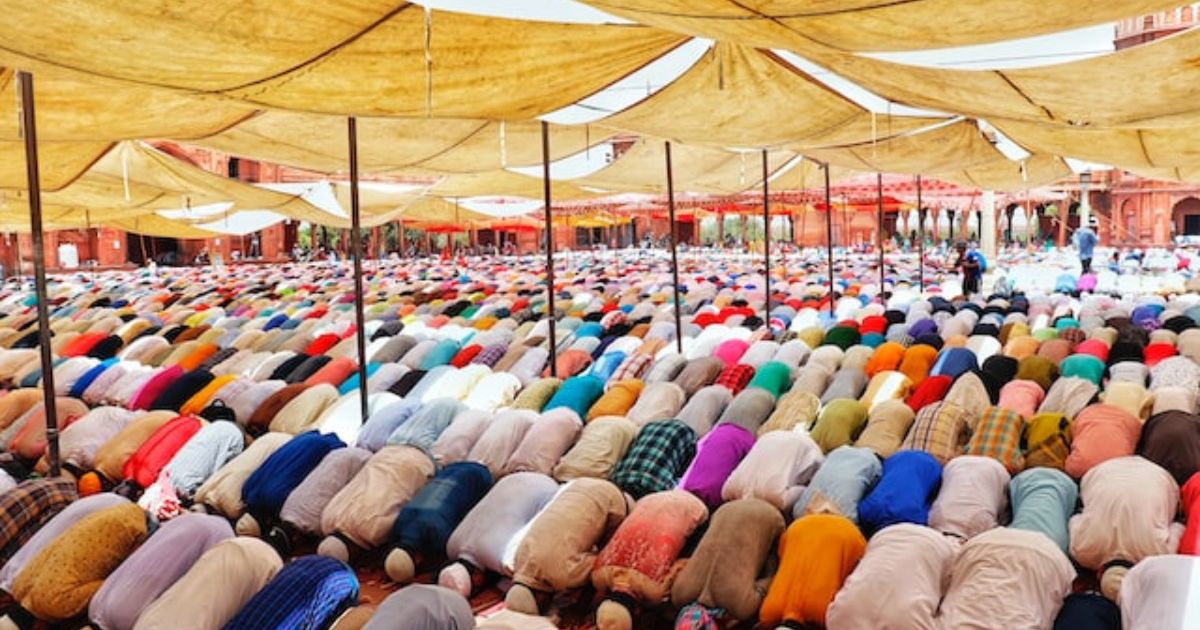
In Islamic religion, salah, or daily Muslim prayer, is more than only the obligatory prayers that Muslims must perform every day. However, prayer is also regarded as a means of communicating with Allah SWT. Salah is highly regarded in Islam, and it is stated in various Quranic and hadith passages below;
Prayer as a source of patience: "O you who have believed, seek help through patience and prayer. Indeed, Allah is with the patient." (Al-Baqarah, 2:153).
Brings tranquility to the heart: “Those who have believed and whose hearts are assured by the remembrance of Allah . Unquestionably, by the remembrance of Allah hearts are assured.” (Ar-Ra’d, 13:28)
As a means of self-purification: "Recite, [O Muhammad], what has been revealed to you of the Book and establish prayer. Indeed, prayer prohibits immorality and wrongdoing, and the remembrance of Allah is greater. And Allah knows that which you do." (Al-Ankabut, 29:45).